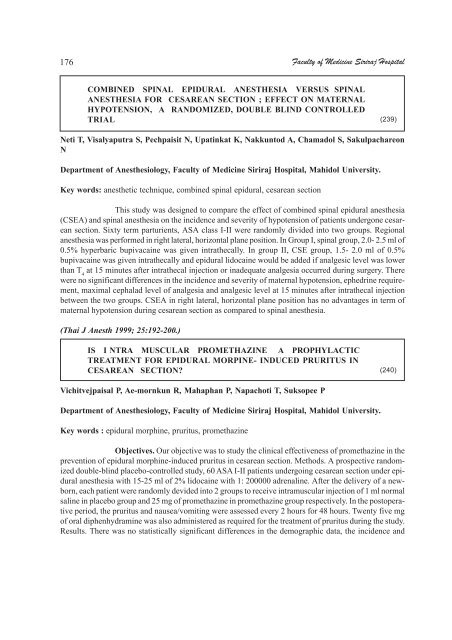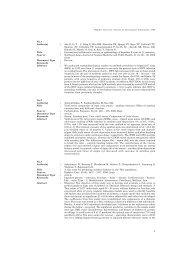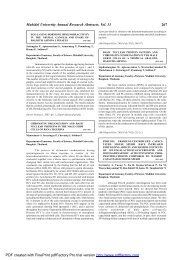THE OSTIA VENAE HEPATICAE AND THE RETHROHEPATIC ...
THE OSTIA VENAE HEPATICAE AND THE RETHROHEPATIC ...
THE OSTIA VENAE HEPATICAE AND THE RETHROHEPATIC ...
You also want an ePaper? Increase the reach of your titles
YUMPU automatically turns print PDFs into web optimized ePapers that Google loves.
176<br />
COMBINED SPINAL EPIDURAL ANES<strong>THE</strong>SIA VERSUS SPINAL<br />
ANES<strong>THE</strong>SIA FOR CESAREAN SECTION ; EFFECT ON MATERNAL<br />
HYPOTENSION, A R<strong>AND</strong>OMIZED, DOUBLE BLIND CONTROLLED<br />
TRIAL<br />
Neti T, Visalyaputra S, Pechpaisit N, Upatinkat K, Nakkuntod A, Chamadol S, Sakulpachareon<br />
N<br />
Department of Anesthesiology, Faculty of Medicine Siriraj Hospital, Mahidol University.<br />
Key words: anesthetic technique, combined spinal epidural, cesarean section<br />
This study was designed to compare the effect of combined spinal epidural anesthesia<br />
(CSEA) and spinal anesthesia on the incidence and severity of hypotension of patients undergone cesarean<br />
section. Sixty term parturients, ASA class I-II were randomly divided into two groups. Regional<br />
anesthesia was performed in right lateral, horizontal plane position. In Group I, spinal group, 2.0- 2.5 ml of<br />
0.5% hyperbaric bupivacaine was given intrathecally. In group II, CSE group, 1.5- 2.0 ml of 0.5%<br />
bupivacaine was given intrathecally and epidural lidocaine would be added if analgesic level was lower<br />
than T 4 at 15 minutes after intrathecal injection or inadequate analgesia occurred during surgery. There<br />
were no significant differences in the incidence and severity of maternal hypotension, ephedrine requirement,<br />
maximal cephalad level of analgesia and analgesic level at 15 minutes after intrathecal injection<br />
between the two groups. CSEA in right lateral, horizontal plane position has no advantages in term of<br />
maternal hypotension during cesarean section as compared to spinal anesthesia.<br />
(Thai J Anesth 1999; 25:192-200.)<br />
IS I NTRA MUSCULAR PROMETHAZINE A PROPHYLACTIC<br />
TREATMENT FOR EPIDURAL MORPINE- INDUCED PRURITUS IN<br />
CESAREAN SECTION?<br />
Vichitvejpaisal P, Ae-mornkun R, Mahaphan P, Napachoti T, Suksopee P<br />
Department of Anesthesiology, Faculty of Medicine Siriraj Hospital, Mahidol University.<br />
Key words : epidural morphine, pruritus, promethazine<br />
Faculty of Medicine Siriraj Hospital<br />
Objectives. Our objective was to study the clinical effectiveness of promethazine in the<br />
prevention of epidural morphine-induced pruritus in cesarean section. Methods. A prospective randomized<br />
double-blind placebo-controlled study, 60 ASA I-II patients undergoing cesarean section under epidural<br />
anesthesia with 15-25 ml of 2% lidocaine with 1: 200000 adrenaline. After the delivery of a newborn,<br />
each patient were randomly devided into 2 groups to receive intramuscular injection of 1 ml normal<br />
saline in placebo group and 25 mg of promethazine in promethazine group respectively. In the postoperative<br />
period, the pruritus and nausea/vomiting were assessed every 2 hours for 48 hours. Twenty five mg<br />
of oral diphenhydramine was also administered as required for the treatment of pruritus during the study.<br />
Results. There was no statistically significant differences in the demographic data, the incidence and<br />
(239)<br />
(240)

















